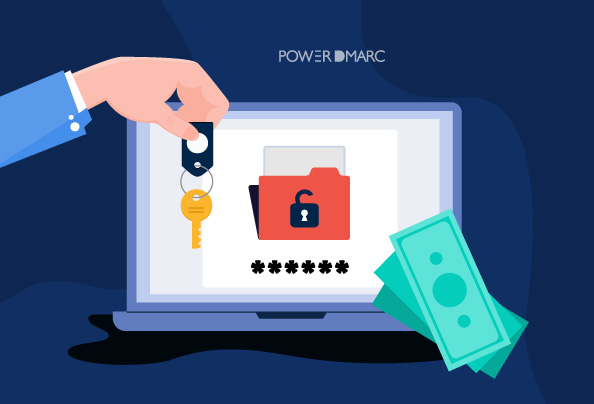One of the largest focuses for email security in the last year has been around DMARC and ransomware has emerged as one of the most financially damaging cybercrimes of this year. Now what is DMARC? Domain-Based Message Authentication, Reporting and Conformance as an email authentication protocol is used by domain owners of organizations big and small, to protect their domain from Business Email Compromise (BEC), direct domain spoofing, phishing attacks and other forms of email fraud.
DMARC helps you enjoy multiple benefits over time like a considerable boost in your email deliverability, and domain reputation. However a lesser known fact is that DMARC also serves as the first line of defense against Ransomware. Let’s enunciate how DMARC can protect against Ransomware and how ransomware can affect you.
Key Takeaways
- DMARC is essential for protecting organizations from ransomware and email fraud by authenticating outgoing emails.
- Ransomware is frequently delivered through phishing emails, often impersonating legitimate sources to trick users.
- Implementing an enforced DMARC policy significantly reduces the likelihood of malicious emails reaching your recipients.
- Security vulnerabilities within email systems can make any organization a target for ransomware attacks.
- Regular monitoring and updates to your email authentication protocols are vital to maintaining email security and brand reputation.
What is Ransomware?
Ransomware is a type of malicious software (malware) that is installed on a computer, usually through the use of malware. The goal of the malicious code is to encrypt files on the computer, after which it typically demands payment in order to decrypt them.
Once the malware installation is in place, the criminal demands a ransom be paid by the victim to restore access to the data. It allows cybercriminals to encrypt sensitive data on computer systems, effectively protecting it from access. The cybercriminals then demand the victim pay a ransom sum to remove the encryption and restore access. Victims are typically faced with a message that tells them their documents, photos, and music files have been encrypted and to pay a ransom to allegedly “restore” the data. Typically, they ask the users to pay in Bitcoin and inform them how long they have to pay to avoid losing everything.
Simplify Ransomware Security with PowerDMARC!
How Does Ransomware Work?
Ransomware has shown that poor security measures put companies at great risk. One of the most effective delivery mechanisms for ransomware is email phishing. Ransomware is often distributed through phishing. A common way this occurs is when an individual receives a malicious email that persuades them to open an attachment containing a file they should trust, like an invoice, that instead contains malware and begins the infection process.
The email will claim to be something official from a well-known company and contains an attachment pretending to be legitimate software, which is why it is very likely that unsuspecting customers, partners, or employees who are aware of your services would fall prey to them.
Security researchers have concluded that for an organization to become a target of phishing attacks with malicious links to malware downloads, the choice is ” opportunistic.” A lot of ransomware doesn’t have any external guidance as to who to target, and often the only thing guiding it is pure opportunity. This means, any organization whether it is a small business or a large enterprise, can be the next target if they have loopholes in their email security.
2021 recent security trends report have made the following distressing discoveries:
- Since 2018, there has been a 350% rise in ransomware attacks making it one of the most popular attack vectors in recent time.
- Cyber security experts believe there will be more ransomware attacks than ever in 2021.
- More than 60% of all ransomware attacks in 2020 involved social actions, such as phishing.
- New ransomware variants have increased by 46% in the last 2 years
- 68,000 new ransomware Trojans for mobile have been detected
- Security researchers have estimated that every 14 seconds a business falls victim to a ransomware attack
Does DMARC Protect Against Ransomware? DMARC and Ransomware
DMARC is the first line of defense against ransomware attacks. Since ransomware is usually delivered to victims in the form of malicious phishing emails from spoofed or forged company domains, DMARC helps protect your brand from being impersonated, which means such fake emails will be marked as spam or not get delivered when you have the protocol correctly configured. DMARC and Ransomware: how does DMARC help?
- DMARC authenticates your emails against SPF and DKIM authentication standards that helps filter malicious IP addresses, forgery and domain impersonation.
- When a phishing email curated by an attacker with a malicious link to install ransomware arising from your domain name reaches a client/employee server, if you have
- DMARC implemented the email is authenticated against SPF and DKIM.
- The receiving server tries to verify the sending source and DKIM signature
- The malicious email will fail verification checks and ultimately fail DMARC authentication due to domain misalignment
- Now, if you have implemented an enforced DMARC policy mode (p=reject/quarantine) the email after failing DMARC will either get marked as spam, or rejected, nullifying the chances of your receivers falling prey to the ransomware attack
- Finally, evade additional SPF errors like too many DNS lookups, syntactical errors and implementation errors by flattening the SPF record, to prevent your email authentication protocol from being invalidated
- This ultimately safeguards your brand’s reputation, sensitive information and monetary assets
The first step to gaining protection against ransomware attacks is to sign up for DMARC analyzer today! We help you implement DMARC and shift to DMARC enforcement easily and in the least possible time. Start your email authentication journey today with DMARC.
